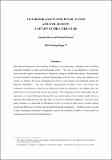Livelihood Adaptation, Public Action and Civil Society: A Review of the Literature
Abstract
The political dimensions of sustainable livelihoods are explored here, drawing on the livelihood
adaptation literature in India and Sub-Saharan Africa. The focus is on adaptation to short-term
shocks and the negative consequences of longer-term change in livelihood strategies. Relationships
of social exclusion, in particular gendered relationships with the state, formal and informal civil
society, are found to be key in determining the effects of interventions into livelihood systems for
different stakeholders. The very different configurations of public action, civil society and
community involvement in reinforcing livelihood activities are compared, to see whether there are
useful lessons to be transferred between the regions. The complexity of these relationships and the
importance of societal differences between the two regions indicate that no single model offers an
optimum relationship between the state and civil society in livelihood adaptation. However, many
policy initiatives are advocated for Sub-Saharan Africa as a result of their success in India, without
considering differences in formal and informal institutional arrangements. Attention needs to be paid
to these underlying institutional arrangements, and to the outcomes of public or social action on
livelihood activities for different stakeholders.
Citation
Davies, S. & Hossain, N. (1997) Livelihood Adaptation, Public Action and Civil Society: A Review of the Literature, IDS Working Paper 57, Brighton: IDS.Is part of series
IDS working papers;57Library catalogue entry
http://bldscat.ids.ac.uk/cgi-bin/koha/opac-detail.pl?biblionumber=111484Rights holder
Institute of Development StudiesCollections
- IDS Research [1671]

